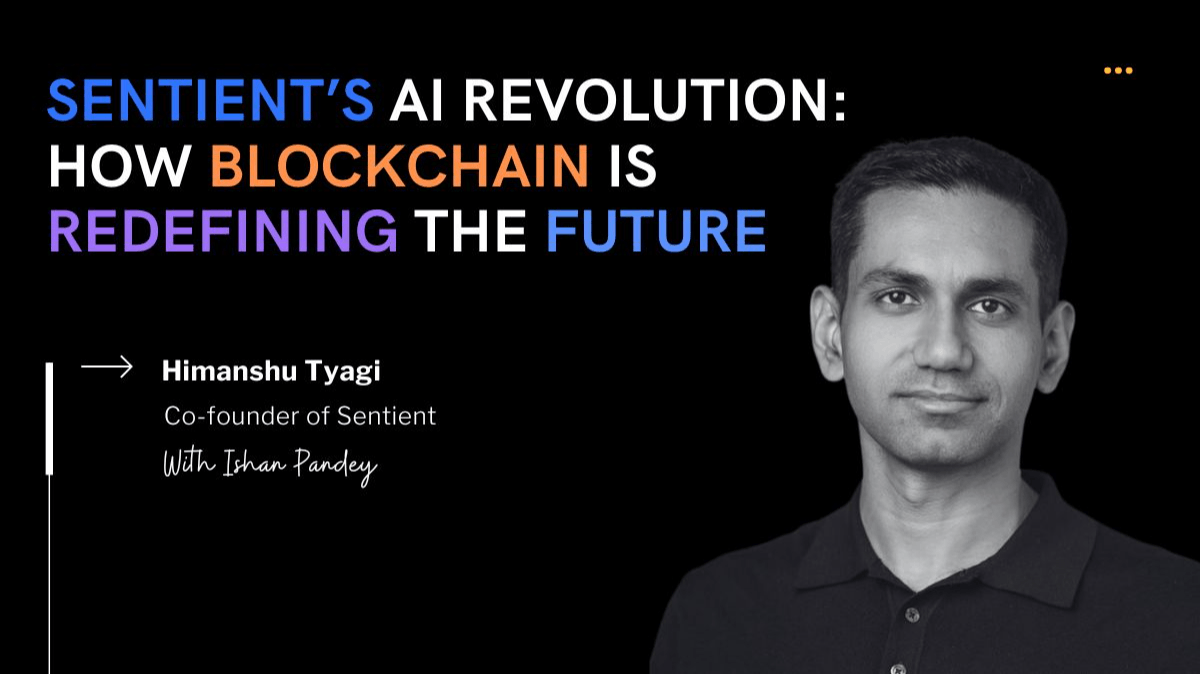Sentient has carved out a unique path, blending blockchain technology with open-source AI to create a community-owned ecosystem. With over 1 million waitlist sign-ups for Sentient Chat in just 24 hours and a record-breaking 650,000 NFT mint for their decentralized AI model, Dobby, Sentient is redefining the future of AI.
At the helm of this revolution is Himanshu Tyagi, Co-founder of Sentient and a Professor at the Indian Institute of Science, whose expertise in AI and blockchain is driving innovations like the Reasoning Agent and a Perplexity-rivaling chatbot. We sit down with Himanshu to explore the technical challenges, groundbreaking solutions, and ambitious vision behind Sentient’s rise.
Ishan Pandey: Sentient Chat has exploded onto the scene with over 1 million waitlist sign-ups in under 24 hours. What technical challenges did you face in building an AI platform that’s both decentralized and consumer-friendly?
Himanshu Tyagi: Decentralization is foundational to our mission, extending far beyond just Sentient Chat. We believe that the future of AI must be open and community-driven, as decentralization uniquely empowers active community participation. This philosophy cascades directly into our products—most notably, Sentient Chat.
With Sentient Chat, our goal is to ensure that the community truly feels ownership. Users aren’t merely passive consumers; they are creators, molders, and stewards of the platform. They have full control—from the underlying AI model and agents, to data and governance—enabling them to shape the product precisely to fit their diverse needs and use cases.
Critically, decentralization and usability reinforce each other in Sentient Chat. By empowering users to customize and enhance the platform, every innovation developed by one user or team becomes accessible to the broader community. This collective contribution enriches the platform’s usability, continually driving improvements and innovations that benefit everyone involved.
Ultimately, decentralization doesn’t complicate the user experience—it enhances it, creating a vibrant ecosystem where collective creativity and collaboration translate directly into a more powerful, flexible, and user-friendly platform.
Ishan Pandey: You’ve positioned Sentient Chat as a competitor to Perplexity, powered by Dobby, the world’s first community-owned AI model. Can you walk us through the technical innovation behind Dobby and how it supports Sentient Chat’s unique capabilities?
Himanshu Tyagi: AI is rapidly becoming the intermediary between information networks and users, granting it significant power to influence user perspectives based on inherent biases. Our goal is to empower communities by enabling them to align AI models according to their specific values, thus promoting a diverse ecosystem of “Loyal AI” models. While biases will always exist due to training data, users should not be limited to generalized models that simply average internet opinions. Instead, we envision users selecting from a wide array of models aligned with distinct community values.
Dobby represents the first of such models, explicitly aligned with the crypto community’s values—pro-crypto and pro-personal freedom. With Dobby, we’ve achieved three notable technical breakthroughs:
-
Effective Value Alignment Without Performance Loss: Aligning AI models to specific values through fine-tuning is notoriously challenging, often leading to degraded performance and incoherent outputs. With Dobby, we’ve successfully fine-tuned the Llama model to embrace specific values while maintaining excellent performance across critical benchmarks.
-
Human-centric Tone and Freedom of Expression with Safety: Achieving our desired alignment required removing existing guardrails from Llama and carefully rebuilding them. Surprisingly, this process enhanced the model’s tone, resulting in more natural and human-centric interactions. Even with relaxed constraints, Dobby remains safe, as demonstrated by metrics from our “Sorry Bench.” Moreover, our Dobby-mini 8B and Dobby 70B models exhibit granular control over specific safety dimensions (such as hate speech, financial, medical, and legal advice, and explicit content), allowing us precise adjustments of the model’s safety profile.
-
Fingerprinting for the Most Distributed Model Ownership Ever: Dobby is currently the most widely distributed model, with over 660,000 owners. This unprecedented level of distribution is facilitated by our innovative fingerprinting technology. Fingerprinting injects unique key-response pairs into the model, enabling robust verification of ownership. These fingerprints have a negligible impact on overall model performance and are resilient to removal through fine-tuning, model merging, or other modifications.
Sentient Chat is our AI-powered search platform, designed to showcase and provide users with a direct experience of the intangible concept of Loyal AI. This platform demonstrates the competitive edge of open-source ecosystems, successfully outperforming platforms like Perplexity and matching the search benchmarks of ChatGPT.
Powered by Dobby, Sentient Chat illustrates how Loyal AI can directly influence the information delivered to users, presenting content concisely and engagingly. The integration of Dobby into Sentient Chat has notably improved the efficiency and entertainment value of search interactions. With Dobby’s clear, human-like, no-nonsense communication style, users can quickly and effectively access the information they seek, highlighting the platform’s distinct advantage in AI-driven search experiences.
Himanshu Tyagi: Recent advancements have shown that generating executable Python code for tool calling yields a significant boost in performance compared to conventional JSON-based approaches. In particular, LLM’s are inherently adept at compressing the action-space of tasks using code. This naturally prompted the use of code as the mode of expression for our reasoning agent. Sometimes LLM’s write code that does not execute/run the way it is intended to, this is remedied by a Python interpreter which checks if the code generated executes or throws errors, if it throws errors, then it will keep regenerating the code (with the previous error traces) until it outputs satisfactory code.
Another caveat is that the LLM may generate functional code that does not do what it is intended to do (e.g. calls the calculator tool instead of searching); the reasoning agent is capable of digesting the output of the information and assessing whether it fits with, on a general level, what it expects from the particular code/tool call.
We tested two different types of agents in the Open Reasoning Agent portion of the ODS framework: Chain-of-Thought with ReAct agent and Chain-of-Code with CodeAct agent.
In the Chain-of-Thought ReAct architecture, the agent follows an iterative reasoning-action loop. First, the ‘Think’ step allows the agent to reason internally, articulating plans or interpreting intermediate results in natural language. Whenever the agent encounters uncertainty or lacks critical information, it invokes the ‘Search’ tool, actively retrieving external information from the web. For arithmetic or computational tasks that require high precision, the agent utilizes the ‘Calculate’ tool. Thus, CoT-ReAct continuously cycles through thinking, searching, and calculating as needed, until it arrives at a reliable solution.
On the other hand, the Chain-of-Code or CodeAct agent employs executable code to perform its reasoning tasks. Initially, the agent thinks through its strategy, similar to CoT-ReAct. However, instead of relying purely on natural language, it generates executable Python code as part of its reasoning. The ‘Calculate’ function is seamlessly embedded here, directly integrated into the Python execution environment. This allows for accurate computations and algorithmic reasoning. Like CoT-ReAct, CodeAct also uses the ‘Search’ tool when additional external information is necessary, incorporating the results directly into its code-generation and execution processes.
The key difference lies in how each agent interacts with these tools. For CoT-ReAct, ‘Think’, ‘Search’, and ‘Calculate’ are distinctly separate actions explicitly chosen during reasoning. For CodeAct, while ‘Think’ remains an explicit planning step, ‘Calculate’ is inherently built into the code execution itself, making computational tasks integral rather than external. ‘Search’ remains similarly explicit in both approaches, providing vital external context whenever the agent’s internal knowledge is insufficient.
Ishan Pandey: Sentient completed a record-breaking 650,000 NFT mint for Dobby, tying ownership to a decentralized AI model. What technical infrastructure did you build to handle this scale, and how does blockchain enhance the community ownership aspect?
Himanshu Tyagi: This was not a technically challenging problem – modern blockchains can easily handle such load. The most interesting part here is that this is the first time anybody has demonstrated this scale of “direct democracy” in model governance. In centralized companies, this governance is done by a tiny alignment team which has sometimes even modified the model to match its own beliefs. Anthropic had done some simple experiments under the name of constitutional AI with about 1000 people, but nothing close to this open governance by community. We wanted to give this power to the people and blockchains are perfect instruments for that. Dobby community already decided what kind of persona Dobby should have, leashed or unhinged (they chose unhinged over leashed). In future, all decisions about Dobby-unhinged model will be taken by this community, who will also get rewarded as model usage increases.
Going forward, these ownership NFTs will be converted to ownership tokens on our blockchain which can be used to govern alignment and updates to this model. Furthermore, the associated fingerprints will be committed as Merkle root to the same contract – anyone can verify the identity of the model by asking our fingerprint queries, and can check that the same queries are committed with the ownership contract.
Himanshu Tyagi: When comparing our open-source platform to closed-source competitors, the primary competitive advantage of closed systems has traditionally been their technology. However, platforms like Sentient Chat and Open Data Sources (ODS) have effectively leveled the playing field by democratizing AI knowledge, making our framework completely open to the community. Closed-source platforms, such as those by OpenAI, operate as black boxes; neither you, I, nor anyone else can fully comprehend their internal processes.
In contrast, our open framework invites continuous innovation from the wider community, enabling rapid identification and resolution of gaps that might otherwise remain unnoticed. This collaborative, open-input and open-output approach is key to building the best possible search platform. Our ultimate vision includes enabling users to contribute their own data sources and agents, thereby drastically enhancing Sentient Chat and ODS through collective, community-driven improvements.
Ishan Pandey: You’ve emphasized Sentient Chat’s edge over competitors like Perplexity with its 15+ AI agent integration. What technical challenges did integrating multiple agents into a single chatbot interface present, and how did you solve them?
Himanshu Tyagi: Technically, we are addressing many complex software and design challenges to allow a broad variety of agents to participate in a singular user experience through Sentient Chat. We are also offering many tools to these agent builders such as our state-of-the-art AI search APIs, the Sentient Secure Enclave offering for building “unruggable agents,” etc. But more than addressing these technical challenges, the most interesting part here is the possibility of a completely new way to access internet knowledge.
For decades, Google has dominated search by focusing primarily on helping users find information online. Google’s reliance on advertising revenue, rooted in recommending sources for information, inherently limits its ability to innovate beyond traditional information retrieval. AI, on the other hand, provides an opportunity to bypass mere information gathering, enabling users to directly execute tasks without needing separate analysis and action phases, which is our exact competitive advantage against the behemoth of Google.
This ambitious vision requires a diverse ecosystem—one that integrates varied indexed data sources with numerous AI agents capable of performing specialized actions. The key to unlocking this potential lies in creating a transparent and open platform, actively incentivizing broad community participation. Data providers must clearly understand the value their contributions bring, while agent developers must seamlessly integrate their services to enhance overall functionality. Such an ecosystem must be community-governed, ensuring fairness, openness, and continual innovation driven by collective contribution and collaboration.
By the way, a lot more than 15 agents are coming on Sentient Chat!
Ishan Pandey: Looking ahead, what’s next for Sentient in terms of technical innovation? How do you plan to evolve the Reasoning Agent and expand the open AGI ecosystem?
Himanshu Tyagi: We see a future where AI becomes an intermediary between all human senses, global information, and social networks. Sentient’s vision is to make sure that this AI is loyal to us. This singular objective drives all our development. For reasoning agents, we want to make sure that developers get access to models whose reasoning capabilities and skills are aligned with their interests or the use case.
For instance, if you are building a sovereign agent that can control wallets, the underlying models should have reasoning capabilities to ensure that malicious actors cannot manipulate prompts and steal funds. This is alignment – we will be building such aligned models. Every developer building in the Open AGI ecosystem should have the option of using AI models that will be loyal to their application or users. Sentient Chat is the collective offering of all such agents built on Loyal AI.
Don’t forget to like and share the story!
Vested Interest Disclosure: This author is an independent contributor publishing via our










